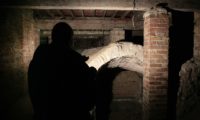 The remains of poet Samuel Taylor Coleridge have been rediscovered in a bricked-up wine cellar. Their loss was of recent duration. Just before his death in 1834, the author of The Rime of the Ancient Mariner was lodging at the home of a doctor in Highgate, north London, who was attempting to treat him. When those attempts failed to prevent the poet’s death, he was buried in Old Highgate Chapel near the parish church across the street.
The remains of poet Samuel Taylor Coleridge have been rediscovered in a bricked-up wine cellar. Their loss was of recent duration. Just before his death in 1834, the author of The Rime of the Ancient Mariner was lodging at the home of a doctor in Highgate, north London, who was attempting to treat him. When those attempts failed to prevent the poet’s death, he was buried in Old Highgate Chapel near the parish church across the street.
In 1961, an alarm was raised about the condition of the vault. It was derelict and Coleridge’s remains were no longer safe. A fundraising campaign that received contributions from all over the world was launched and its success allowed Coleridge’s remains, those of his wife Sarah, his daughter Sarah, her husband and their son to be moved to St. Michael’s Parish Church where they were placed in a section of the crypt that in the 17th century had been a wine cellar. When the church was built on the site of the former Ashhurst House in 1831, the old wine cellar had been absorbed into the large crypt of the new St Michael’s and largely forgotten. Coleridge got a marker in the floor of the church, but the coffins themselves were bricked up and forgotten about.
[I]n the words of Drew Clode, a member of the St Michael’s stewardship committee, “poor Coleridge was moved from a tip to a tip – they put the coffins in a convenient space which was dry and secure, and quite suitable, bricked them up and forgot about them, and never did anything about the rest of the space”.
As people died or moved away from the parish, the exact location of the coffins was forgotten, until a recent excavation revealed the entrance to the wine vault. The gap was just large enough to shine a torch through the ventilation block in the 1960s brick wall, and the excavators discovered the five lead coffins. They lay not where most thought, in the far corner of the crypt, but almost directly below the inscription “Beneath this stone lies the body of Samuel Taylor Coleridge” on the prominent memorial slab in the nave. “So that was a bit of a clue really,” said Clode.
Pilgrims do visit the church to pay their respects to the poet, and it would be nice to have more than just a marker for them to see. St. Michael’s authorities want to clear the crypt and make it accessible without having to follow a labyrinthine path through piles of brick and stone.
“From a safety point of view it would be quite impossible to bring members of the public down here,” said the vicar, Kunle Ayodeji. “But we hope that the whole crypt can be cleared as a space for meetings and other uses, which would also allow access to Coleridge’s cellar. I don’t think we would open up a view of the coffins, but we could place a suitable inscription on the wall.”
So twice six yards of Vaulted Burial Ground
With Bricks and Walls were compass’d round?
Yeah! – All who heard should see them there,
No need to cry, Beware! Beware!
But really Ancient Albatrosses,
Instead of English Christian Crosses?
————
The vicar says, there would be no way to bring members of the public down there, but he hopes that the crypt can be cleared as a space for meetings and “other uses”?
— I reckon, members of the public might wonder if the vicar already has a “wine cellar” :confused:
“Building committee meeting in the crypt at 10:00.” Eye roll.
For the love of God, Montresor!
Geraldo should have been there! 😆
Wine seller! More wine! In the cellar!
Thanks for all of the great suggestions. We have plans to visit this part of Spain and its nice to know there are so many fun and free things to do in the area. I know I would love visiting the neat sounding parks. Become a personal trainer
Thanks for all of the great suggestions. We have plans to visit this part of Spain and its nice to know there are so many fun and free things to do in the area. I know I would love visiting the neat sounding parks.